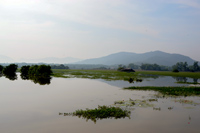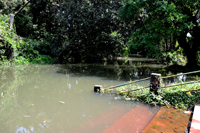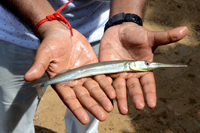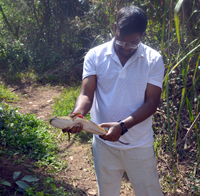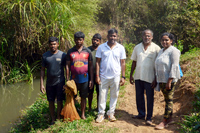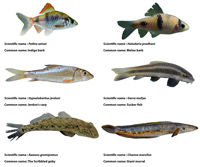
Exploration of Ramsar Site Nanda lake, Goa for Assessment of Fish Faunal Diversity for conservation and management
Exploration of Ramsar Site Nanda lake, Goa for Assessment of Fish Faunal Diversity for conservation and management
ICAR-CCARI documented the fish diversity of Goa from rivers, estuaries, wetlands, ponds coral reefs, and coastal ecosystems. The institute has also done ecosystem health assessments of different estuaries of Goa using ecological modelling. The institute has already submitted the draft list of fish species from Goa to the Goa State Biodiversity Board (GSBB). Recently, 15 wetlands were notified from Goa state, where ICAR is also an active partner in the preparation of the documents being an advisory body to the Goa State Wetland Authority (GSWA). For the first time, Nanda Lake in Goa received Ramsar status (wetlands of international importance) with these collective efforts. In this context, ICAR-CCARI initiated the documentation of fish faunal diversity of Nanda Lake and revealed significant findings, shedding light on the biodiversity of this Ramsar site. Under the supervision of Shri Trivesh Suresh Mayekar (Scientist, ICAR-CCARI), the study emphasizes the urgency for conserving habitats hosting a wide variety of fish fauna.
Nanda Lake is situated in the Quepem municipality, Village Quepem, Quepem Taluka, in south Goa, covering an area of 64.5 ha of land amidst intermittent freshwater marshes adjacent to a major tributary of the Zuari River. As the sole Ramsar site in the state of Goa, it plays a crucial role in the region's ecosystem. These marshes are connected to the river channel through a sluice gate, facilitating flooding when closed. This wetland ecosystem supports diverse migratory water birds, as well as a rich array of plants, animals, and fish species.
The field survey identified a total of 17 fish species within the Ramsar site. However, concerning observations were made regarding the decline in fish species diversity, as reported by local fishermen and residents. Among the identified species, two, namely Pethia setnai and Haludaria pradhani, are classified as threatened according to the IUCN Red List. Notably, these species were only observed at one of the five sampling sites, indicating habitat destruction and the urgent need for conservation measures.
The presence of threatened fish species underscores the vulnerability of Nanda Lake's aquatic habitats. Habitat destruction has led to a major decrease in fish faunal diversity. Based on the survey findings, it is imperative to implement more robust conservation policies and management practices in Nanda Lake and its surrounding areas. Collaborative initiatives involving stakeholders, governmental bodies, and local communities are essential for the sustainable management of this vital ecosystem.
In conclusion, the preliminary survey conducted by the ICAR-CCARI team has provided valuable insights into the fish faunal diversity of Nanda Lake. The presence of threatened species highlights the urgent need for conservation action to safeguard this Ramsar site and its associated habitats. ICAR-CCARI plans to bypass this declining fish stock by collecting the brood stock available and producing them in a captive environment. By addressing conservation concerns and implementing effective management strategies, we can ensure the long-term preservation of Nanda Lake's rich biodiversity for future generations. The research team included Shri. Trivesh Mayekar, Dr. Sreekanth GB (Scientists from CCARI), Mr. Melbin Lal, Mr. BB Borges (research scholars of CCARI), Ms. Shruti S (Project assistant, GSWA) and Ms. Samiksha C (Programme officer, GSBB).
